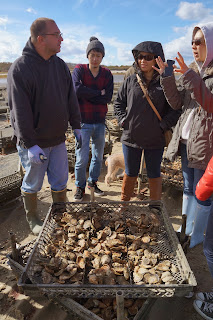The East Coast Shellfish Research Institute, an arm of the East Coast Shellfish Growers Association, has received a grant from USDA/NIFA Risk Management Education Northeast Center to do a workshop in all of the northeast coastal states. The focus of these workshops is to help growers document the environmental soundness of their operation, show how this extremely simple technology can improve their profitability, learn something new and relevant, and understand what to do in case of mortalities in field growout.
Would you like to show your customers and consumers that you really are an environmentally aware shellfish farmer? Would you like to improve the marketing for your crop, as well as know what to do if you have a major mortality? And maybe why it’s a good idea to keep decent production records? Well, this workshop may just be the thing for you!
We will have some hands-on work documenting your operation into an Individual Farm Plan, show how to create a Point of Purchase brochure, learn some other new things, and get some personal attention for growing your future success.
The workshops are free of charge but we’d like you to RSVP to your state Aquaculture Extension Specialist about your participation. We may send some other suggestions about what to bring with you to help the process.
The schedule is as follows:
Delaware
Monday January 20, 2014. 7 to 9PM. University of Delaware, Lewes Campus, Room 104, Cannon Laboratory,
700 Pilottown Road, Lewes, DE19958
Maryland
Tuesday January 21 6:30 to 8:30PM, MD Dept of Natural Resources, C-1 conference room,
580 Taylor Ave, AnnapolisMD
New Jersey
Wednesday January 22, 1 to 4PM. Rutgers Cooperative Extension Office,
, Mays Landing, NJ08330
New York
Thursday January 23, 1 to 4PM, Cornell Cooperative Extension,
423 Griffing Avenue, Riverhead, NY11901
Connecticut
Friday January 24, 1 to 4PM, University of Connecticut, AveryPoint, MarineSciencesBuilding, Room 103,
1080 Shennecossett Road, Groton, CT06340
Rhode Island
Saturday January 25, 1-4PM. Hazard Rooms, Coastal Institute at the Narragansett Bay Campus
215 South Ferry Rd, Narragansett, RI, 02882
Maine
Monday January 27, 1 to 4PM, University of Maine, Hutchinson Center, 80 Belmont Avenue (Route #3) Belfast, Maine 04915
New Hampshire/Northshore Massachusetts
Tuesday January 28, 1 to 3:30PM, University of New Hampshire, Urban Forestry Center, 45 Elwyn Road, Portsmouth, N.H. 03801
Massachusetts
Wednesday January 29, 10AM to 1PM. Harbor View Conference Room, OldJailBuilding - BarnstableSuperior Courthouse Complex,
3195 Main Street, Barnstable, MA02630
Attendees are invited to bring with them all the information they would need to complete the plan (actually not much…state permit numbers mostly). They would create the trifold brochure at home on their own after instruction at the workshop, but people on the grant would be available by phone or email to help with those also after the workshops.
So, put these dates on your calendar so you can attend.











